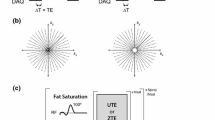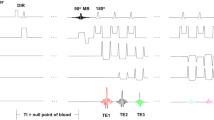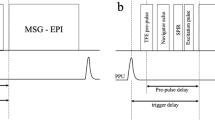Abstract
Objective
The objective of this study was to compare two different schemes for long-T 2 component suppression in ultrashort echo-time (UTE) imaging. The aim was to increase conspicuity of short-T 2 components accessible by the UTE technique.
Materials and methods
A “dual-echo” and a magnetization-preparation approach for long-T 2 and fat suppression were implemented on clinical scanners. Both techniques were compared in 3D UTE exams on healthy volunteers regarding short-T 2 Signal-to-noise ratio (SNR), long-T 2 suppression quality, and scan efficiency. A quantitative SNR evaluation was performed using ankle scans of six volunteers. T 2 suppression profiles were simulated for both approaches to facilitate interpretation of the observations.
Results
At 1.5 T, both techniques perform equally well in suppressing long-T 2 components and fat. Magnetization preparation requires more shimming effort due to the use of narrow-band pulses, while the “dual-echo” technique requires a post-processing step to form a subtraction image. For scans with a short repetition time (TR), the “dual-echo” approach is much faster than the magnetization preparation, which depends on slow T 1 recovery between preparation steps. The SNR comparison shows slightly higher short-T 2 SNR for the “dual-echo” approach. At 3.0 T, magnetization preparation becomes more challenging due to stronger off-resonance effects.
Conclusion
Both techniques are well suited for long-T 2 suppression and offer comparable short-T 2 SNR. However, the “dual-echo” approach has strong advantages in terms of scan efficiency and off-resonance behavior.
Similar content being viewed by others
References
Pauly J, Conolly S, Nishimura D, Macovski A (1989) Slice-selective excitation for very short T 2 species. In: Proceedings 8th annual meeting SMRM, vol 28
Glover GH, Pauly JM, Bradshaw KM (1992) Boron-11 imaging with a three-dimensional reconstruction method. J Magn Reson Imaging 2:47–52
Gold GE, Pauly JM, Macovski A, Herfkens RJ (1995) MR spectroscopic imaging of collagen: tendons and knee menisci. Magn Reson Med 34:647–654
Robson MD, Gatehouse PD, Bydder M, Bydder GM (2003) Magnetic resonance: an introduction to ultrashort echo-time imaging. J Comput Assist Tomogr 27:1–22
Reichert IL, Benjamin M, Gatehouse PD, Chappell KE, Holmes J, He T, Bydder GM (2004) Magnetic resonance imaging of Periosteum with ultrashort TE pulse sequences. Magn Reson Med 19:99–107
Robson MD, Benjamin M, Gishen P, Bydder GM (2004) Magnetic resonance imaging of the Achilles tendon using ultrashort TE (UTE) pulse sequences. Clin Radiol 59: 727–735
Bergin CJ, Pauly JM, Macovski A (1991) Lung parenchyma: projection reconstruction MR imaging. Radiology 179:777–781
Chappel KE, Patel N, Gatehouse PD, Main J, Puri BK, Taylor-Robinson SD, Bydder GM (2003) Magnetic resonance imaging of the liver with ultrashort TE (UTE) pulse sequences. J Magn Reson Imaging 18:709–713
Waldman A, Rees JH, Brock CS, Robson MD, Gatehouse PD, Bydder GM (2003) MRI of the brain with ultra-short echo-time pulse sequences. Neuroradiology 45:887–892
Crowe LA, Wang YX, Gatehouse P, Tessier J, Waterton J, Robert P, Bydder G, Firmin DN (2005) Ex vivo MR imaging of atherosclerotic rabbit aorta labelled with USPIO—Enhancement of iron loaded regions in UTE imaging. In: Proc Intl Soc Mag Reson Med., vol 13, p 115
Gatehouse PD, Bydder GM (2003) Magnetic resonance imaging of short T 2 components in tissue. Clin Radiol 58:1–19
Pauly J, Conolly S, Macovski A (1992) Suppression of long T 2 components for short T 2 imaging. J Magn Reson Imaging 2:145
Terk MR, Gober JR, de Verdier H, Simon HE, Colletti PM (1993) Evaluation of suspected musculoskeletal neoplasms using 3D T 2-weighted spectral presaturation with inversion recovery. Magn Reson Imaging 11:931–939
Larson PEZ, Gurney PT, Nayak K, Gold GE, Pauly JM, Nishimura DW (2006) Designing long-T 2 suppression pulses for ultrashort echo time imaging. Magn Reson Med 56: 94–103
Rahmer J, Börnert P, Groen J, Bos C (2006) 3D Radial ultrashort echo-time imaging with T 2 adapted sampling. Magn Reson Med 55:1075–1082
Wong STS, Roos MS (1994) A strategy for sampling on a sphere applied to 3D selective RF pulse design. Magn Reson Med 32:778–784
Rasche V, Holz D, Proksa R (1999) MR fluoroscopy using projection reconstruction multi-gradient-echo (prMGE) MRI. Magn Reson Med 42:324–334
Liang ZP, Lauterbur PC (2000) Principles of magnetic resonance imaging. IEEE, Inc., New York
Gold GE, Pauly JM, Glover GH, Moretto JC, Macovski A, Herfkens RJ (1993) Characterization of atherosclerosis with a 1.5-T imaging system. J Magn Reson Imaging 3:399–407
Gurney P, Larson P, Nishimura D (2005) Long-T2 suppressed ultra short-TE 3DPR imaging. In: Proc Intl Soc Mag Reson Med., vol 13, p 787
O’Sullivan JD (1985) A fast sinc function gridding algorithm for fourier inversion in computer tomography. IEEE Trans Med Imaging 4:200–207
Aldefeld B, Börnert P (1998) Effects of gradient anisotropy in MRI. Magn Reson Med 39:606–614
Mosher TJ, Dardzinski BJ, Smith MB (2000) Human articular cartilage: influence of aging and early symptomatic degeneration on the spatial variation of T2 - preliminary findings at 3 T. Radiology 214:259–266
Regatte RR, Akella SV, Reddy R (2005) Depth-dependent proton magnetization transfer in articular cartilage. J Magn Reson Imaging 22:318–323
Larson PE, Vidarsson L, Pauly JM, Nishimura DG (2005) Linear combination filtering long-T *2 suppression in ultra-short echo time (UTE) imaging. In: Proc Intl Soc Mag Reson Med., vol 13, p 2264
Author information
Authors and Affiliations
Corresponding author
Rights and permissions
About this article
Cite this article
Rahmer, J., Blume, U. & Börnert, P. Selective 3D ultrashort TE imaging: comparison of “dual-echo” acquisition and magnetization preparation for improving short-T 2 contrast. Magn Reson Mater Phy 20, 83–92 (2007). https://doi.org/10.1007/s10334-007-0070-6
Received:
Revised:
Accepted:
Published:
Issue Date:
DOI: https://doi.org/10.1007/s10334-007-0070-6




